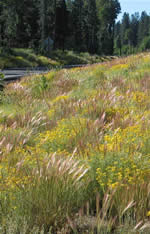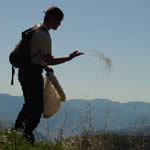 |
Using Native Plant Material

A highly successful roadside restoration project in cooperation with the Federal Highway Administration. Establishing native species along roadsides is aesthetically pleasing and can reduce maintenance requirements. Road right-of-ways also provide connectivity across fragmented landscapes, serving as important dispersal corridors for propagules of desirable native plant species.

A student volunteer hand-seeding native grasses in a restoration project in the Snake River Canyon, Oregon.
Native plant materials are needed for a wide variety of restoration and rehabilitation efforts on National Forests and Grasslands around the country. Native plant materials are used for erosion control, weed prevention, forage, cover, and aesthetics. The types of projects include:
- Post-fire rehabilitation
- Post-harvest seeding or planting
- Decommissioned road beds, cut-and-fill slopes
- Non-native invasive species infestations
- Recreational developments, including trails and campgrounds
- Riparian areas
- Range improvement areas
- Wildlife and fisheries habitat restoration
- Mining reclamation
- Special use sites and corridors
Although the Forest Service has a long history of using native tree species in reforestation, efforts to revegetate with other native plants (hardwood trees and shrubs, grasses, and forb species) is relatively new. As a consequence, supporting research, infrastructure and plant material programs are all in the early stages of development.
Roadside Revegetation
Roadside Revegetation: An Integrated Approach to Establishing Native Plants - This manual was a collaborative effort between Region 6 Forest Service personnel (Scott Riley, David Steinfeld, Lee Riley, Tom Landis (retired)), Kim Wilkinson, and the Federal Highway Administration (Western Federal Lands Highway Division). As described in the Executive Summary (PDF 0.2 MB), the manual guides readers through four stages of revegetation, including initiation, planning, implementation, and monitoring. Although the manual focuses on roadside revegetation, it has great relevance to other types of disturbances and activities where revegetation with native plant materials is desired.
A Manager’s Guide to Roadside Revegetation Using Native Plants (PDF, 3.3 MB) - This guide is intended to support managers in facilitating successful protection and/or establishment of native vegetation as an integral part of road design and construction. This report summarizes the concepts and approaches developed in Roadside Revegetation: An Integrated Approach to Establishing Native Plants, from a manager's perspective. While the full report is designed for field-level practitioners, it is this reference document that engineers and managers should use as a guide in project planning, design, and construction. This guide summarizes an integrated approach to effectively revegetating roadsides and other disturbance areas associated with road construction, modification, or obliteration. Management issues including scope, schedules, budgets, communication, and quality assurance are outlined as they relate to integrating revegetation practices.
Fiscal Year 2007 Reports
The following reports provide the most recent information from around the country about local efforts to identify and characterize target species, collect and propagate seed and planting stock, develop seed zones and plant movement guidelines, provide training, and utilize native plants in restoration. The projects were funded by a special Congressional appropriation for the development and use of native plant materials on National Forest System lands.
Alaska Region
Eastern Region
- Native Plant Restoration and Bank Stabilization along the Indian Wild and Scenic River (Hiawatha National Forest) (PDF, 194 KB)
- Native Lupine Seedbed Establishment for Federally Listed Karner Blue Butterfly Habitat (Huron-Manistee National Foresta) (PDF, 80 KB)
- Development of Native Grass Seed Source in Michigan’s Northern Lower Peninsula (Huron-Manistee National Forests) (PDF, 86 KB)
- Enhancing Pollinator Populations in Restored Prairie Habitats (Midewin National Tallgrass Prairie) (PDF, 122 KB)
- Native Plant Program – Banking on the future (Allegheny National Forest) (PDF, 100 KB)
- FLNF Native Plant Program Development (Fingers Lake National Forest) (PDF, 132 KB)
- Pine Plains Restoration (Hiawatha National Forest) (PDF, 1443 KB)
- Native Plant Production Nursery and Restoration (Hoosier National Forest) (PDF, 268 KB)
- Aldo Leopold Native Plant Demonstration Program (Chequamegon-Nicolet National Forests) (PDF, 143 KB)
- Local Native Seed Collection and Production (Ottawa National Forest) (PDF, 101 KB)
- Production of Dwarf Bilberry for Outplanting (Ottawa National Forest) (PDF, 136 KB)
- Native Woody Seed Collection (Chippewa National Forest) (PDF, 89 KB)
- Native Woody Plant Fruit & Cone Gathering (Chippewa National Forest) (PDF, 102 KB)
- Establishing a Poverty Oats (Danthonia spicata) Production Site (Superior National Forest) (PDF, 210 KB)
- Development of Native Grass and Forb Seed for Shallow Soil Sites (Superior National Forest) (PDF, 167 KB)
Intermountain Region
- Native Plant Seed Bank Development Project (Unita National Forest) (PDF, 73KB)
- Native Grass Seed Collection and Propagation for Habitat Restoration in Idaho (Boise National Forest) (PDF, 124 KB)
- Native Grass Seed Bank Santa Rosa Ranger District (Humboldt-Toiyabe National Forest) (PDF, 151 KB)
- Natives Used on Brundage Ski Area (Payette National Forest) (PDF, 140 KB)
- Colorado Plateau Native Plant Materials Program (Dixie, Fishlake, & Manti La-Sal National Forests) (PDF, 87 KB)
- Slender Wheatgrass (Elymus trachycaulus) and Mountain Brome (Bromus carinatus) evaluation of Seed Collections (Caribou-Targhee and Bridger-Teton National Forests) (PDF, 149 KB)
- Restoration of Degraded Tall Forb Communities (Caribou-Targhee National Forest) (PDF, 257 KB)
- Native Plant Program for Restoration and Rehabilitation (Sawtooth National Forest) (PDF, 137 KB)
- Native Seed Collection and Increase on the Minidoka Ranger District (Sawtooth National Forest) (PDF, 138 KB)
Northern Region
- Whitebark Pine Genetic Restoration Program (Northern Region) (PDF, 114 KB)
- Purchase of Sandberg Bluegrass Seed (Nez Perce National Forest) (PDF, 94 KB)
- Forb and Grass Seed Collections in Bob Marshall Wilderness (Flathead National Forest) (PDF, 131 KB)
- Establishment of native grass and forb seed source for use in integrated weed management in burned areas, roads, and Bob Marshall Wilderness dispersed recreation sites (Flathead National Forest) (PDF, 127 KB)
- Sheep Mountain Grass-Forb Montane Restoration Project (Lolo National Forest) (PDF, 125 KB)
- Idaho Fescue Grow Out (Gallatin National Forest) (PDF, 135 KB)
- Sandberg’s Bluegrass Collection/Grow Out (Gallatin National Forest) (PDF, 98 KB)
- Effectiveness of Native Plant Material for Re-vegetation of Decommissioned Roads (Kootenai (MT) and Clearwater (ID) National Forests) (PDF, 125 KB)
- Stool Bed Production of Native Shrubs to Meet Regional Needs for Rooted Cuttings (Flathead, Bitterroot, Idaho Panhandle, and Lolo National Forests) (PDF, 140 KB)
- Trout Creek Riparian Restoration: Willow Planting Project (Custer National Forest) (PDF, 123 KB)
Pacific Northwest Region
- Dungeness Watershed Native Elk Forage Seed Collection (Olympic National Forest) (PDF, 108 KB)
- Dungeness Collaborative StewardshipNative Seed Collection & Propagation (Olympic National Forest) (PDF, 172 KB)
- Native Seed Collection (Olympic and Mt Baker-Snoqualmie National Forests) (PDF, 145 KB)
- 2007 Accomplishments for North Umpqua, Diamond Lake, and Cottage Grove Districts (Umpqua National Forest) (PDF, 118)
- 2007 Native Plant Material Accomplishments (Deschutes National Forest) (PDF, 150 KB)
- FY 2007 Native Plant Restoration Accomplishments (Fremont-Winema National Forest) (PDF, 132 KB)
- Native Grass Seed Production/Collection (Malheur National Forest) (PDF, 149 KB)
- FY 07 Native Plant Material Accomplishments (Mt. Hood National Forest) (PDF, 101 KB)
- Restoration of native under-story: 2007 Accomplishments (Columbia River Gorge National Scenic Area) (PDF, 182 KB)
- Natives Program (Okanogan and Wenatchee National Forest) (PDF, 95 KB)
- Coastal Meadow Native Seed Increase (Siuslaw National Forest) (PDF, 108 KB)
- 2007 Native Plant Material Accomplishments (Gifford Pinchot National Forest) (PDF, 101 KB)
- FY07 Native Plant Material Accomplishments (Umatilla National Forest) (PDF, 94 KB)
- Seed Collection and Increase, Tiller Ranger District (Umpqua National Forest) (PDF, 181 KB)
- 2007 Accomplishments, Native Seed & Plant Materials Restoration Project (Wallowa-Whitman National Forest) (PDF, 156 KB)
- Riparian Restoration Monument Fire Area (Wallowa-Whitman National Forest) (PDF, 97 KB)
- Native Plant Program: La Grande and Whitman Ranger Districts (Wallowa-Whitman National Forest) (PDF, 162 KB)
- FY07 Native Plant Material Accomplishments (Ochoco National Forest and Crooked River National Grassland) (PDF, 117 KB)
- Native Plant Materials Program (Rogue River-Siskyou National Forest) (PDF, 172 KB)
- Revegetation with Natives Program (Willamette National Forest) (PDF, 148 KB)
Pacific Southwest Region
Rocky Mountain Region
Southern Region
- Jackson Island Native Plant Restoration and Expansion Project (Cherokee National Forest) (PDF, 105 KB)
- South Carolina Piedmont Prairie Natives (Sumter National Forest) (136 KB)
- Initial Georgia Aster Expansion Project (Talladega National Forest) (PDF, 175 KB)
- Georgia Aster Expansion Project (Talladega National Forest) (PDF, 175 KB)
- Propagation and Planting of the Kentucky Ladyslipper Orchid (Kisatchie National Forest) (PDF, 172 KB)
- Native Seed Production Area (Apalachicola National Forest) (PDF, 124 KB)
- Hazardous Fuel Loading Reduction Through the Control of Kudzu (NNIS) and Ecosystem Rehabilitation with Native Plants, Shoal Creek Ranger District (Talladega National Forest) (PDF, 432 KB)
- Native Grass Planting and Hardwood Midstory Removal (Talladega National Forest) (PDF, 112 KB)
- Bring Back the Natives (Oconee National Forest) (PDF, 109 KB)
- Re-establishment of Native Warm Season Grasses in Old-Growth Restoration Areas (Ouachita National Forest) (PDF, 104 KB)
- Wet Prairie Restoration Project (Apalachicola National Forest) (PDF, 135 KB)
Southwestern Region
Research and Development
- Post-wildfire revegetation in southwestern ponderosa pine forest:Native seeds versus annual ryegrass (Rocky Mountain Research Station) (PDF, 87 KB)
- Black Hills National Forest Native Plant Materials Program (Rocky Mountain Research Station) (PDF, 1261 KB)
- Will local adaptation to serpentine soils affect restoration measures in a native California annual plant? (Pacific Southwest Research Station) (PDF, 154 KB)
- Genecology of native grasses for habitat restoration, Phase I: seed collections of Poa secunda and Elymus elmoides for common garden studies 2007 (Pacific Northwest Research Station) (PDF, 168 KB)
- Restoration of pile burned areas to reduce the risk of post-fire weed expansion after fuels treatment, 2006 accomplishments (Rocky Mountain Research Station) (PDF, 100 KB)
- Restoration of pile burned areas to reduce the risk of post-fire weed expansion after fuels treatment, 2007 accomplishments (Rocky Mountain Research Station) (PDF, 55 KB)
- Using weed-resistant native seed mixes to restore burned areas (Rocky Mountain Research Station) (PDF, 51 KB)

Scenes depicting wildland collection and field production of native grass and forb seed. Wildland-collected seed can be used directly in restoration projects, or established in production fields to generate larger quantities of seed.
|

